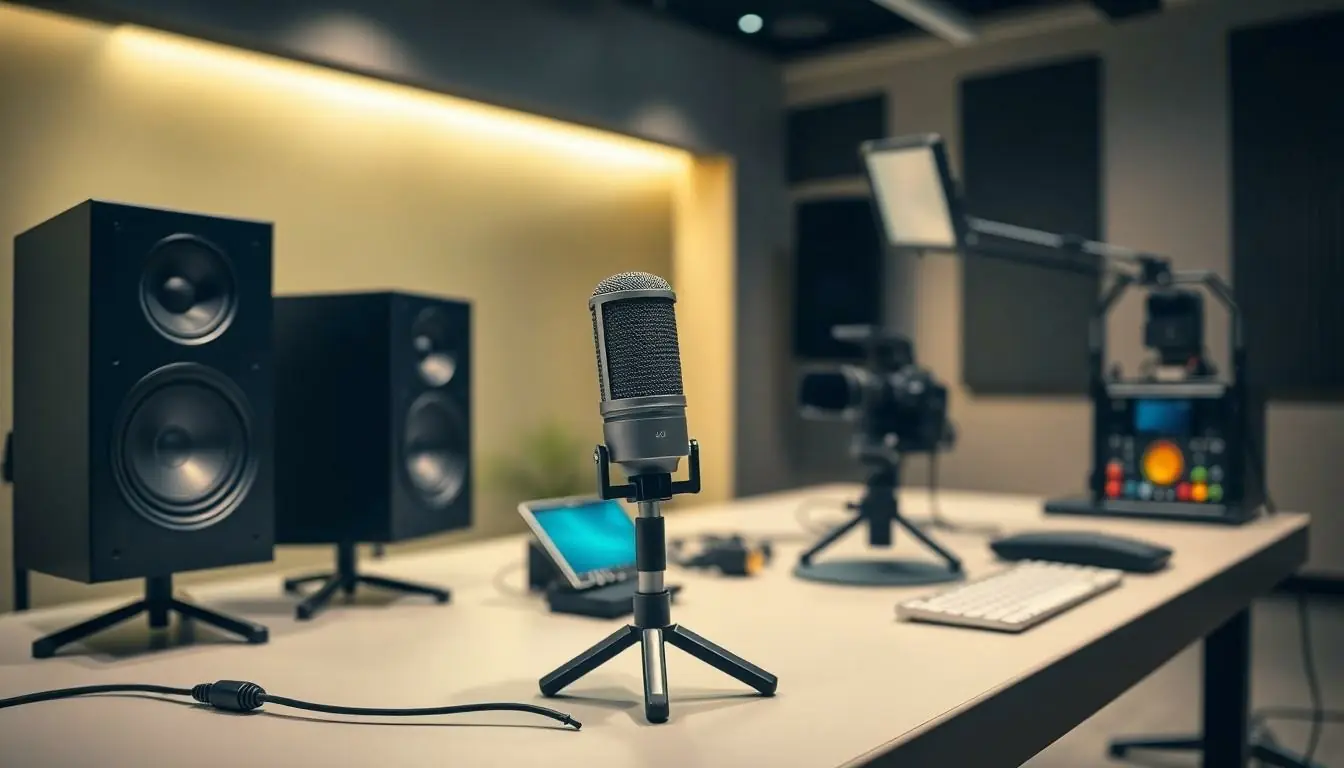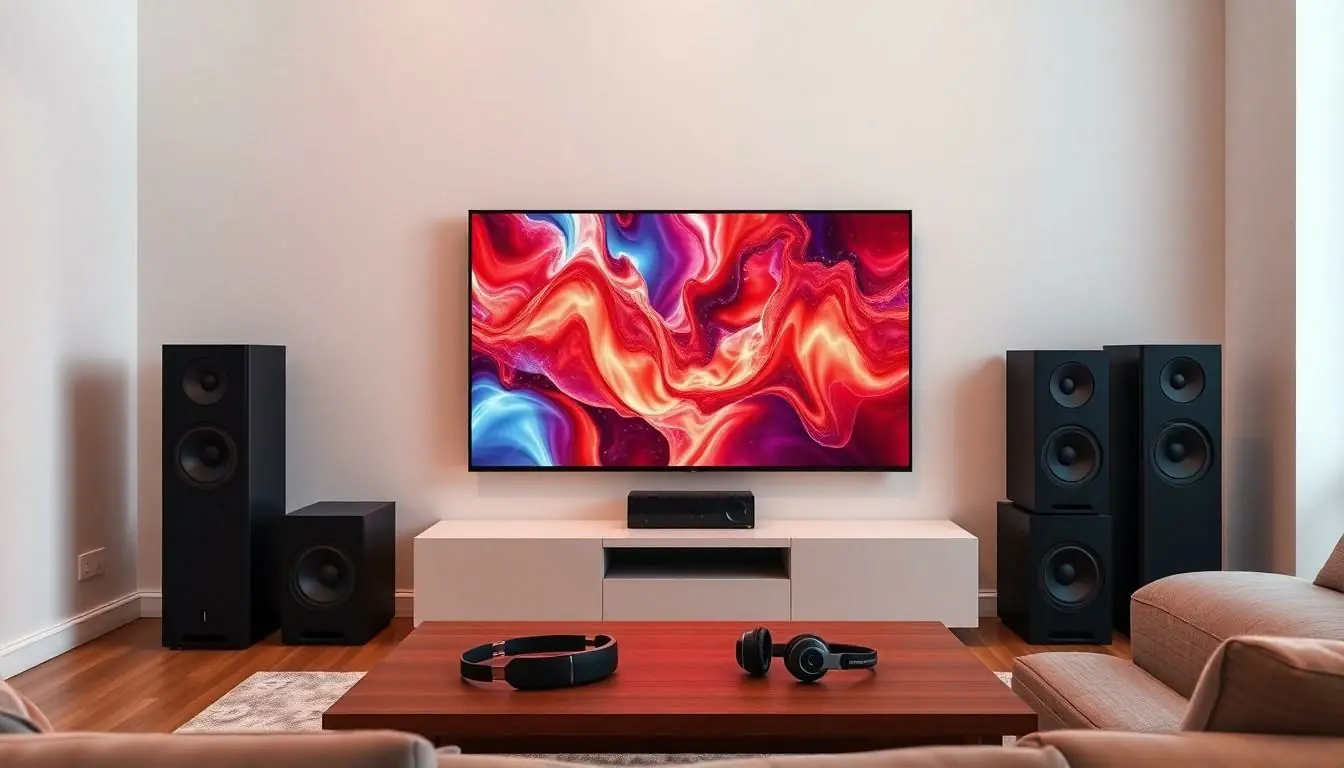Table of Contents
ToggleIn a world where binge-watching and virtual meetings have become the norm, audio video technology is the unsung hero of our daily lives. It’s the magic behind that crystal-clear Zoom call and the reason your favorite show sounds like a symphony rather than a tin can on a string. With the right gear, anyone can transform their living room into a mini cinema or their home office into a state-of-the-art studio.
Overview Of Audio Video Technology
Audio video technology encompasses various tools and systems designed for capturing, processing, and displaying sound and images. This technology significantly enhances communication, entertainment, and information sharing. It includes equipment such as microphones, cameras, speakers, and displays, which are essential for creating immersive experiences.
High-definition video formats, like 4K and 8K, offer improved image clarity and detail. These formats elevate visual experiences in home theaters, virtual events, and professional presentations. Surround sound systems provide audio experiences that draw users into the environment, enhancing everything from movies to gaming sessions.
Streaming platforms utilize audio video technology to deliver content directly to users. Services like Netflix and YouTube adapt to various internet speeds, ensuring smooth playback and consistent quality. Similarly, online meeting applications, such as Zoom and Microsoft Teams, rely on audio video technology to facilitate effective communication, enabling remote collaboration.
New advancements continue to emerge in this field. Innovations such as augmented reality (AR) and virtual reality (VR) leverage audio video technology to create interactive environments. These tools captivate audiences, allowing them to experience content in unique ways.
Accessibility features also enhance user experience by catering to diverse needs. Options for closed captioning and audio descriptions improve content consumption for individuals with hearing or vision impairments.
Finally, the integration of artificial intelligence optimizes audio video technology. AI algorithms enhance image processing and sound quality, ensuring users experience top-tier audio visual performances.
Key Components Of Audio Video Technology

Audio video technology consists of various essential components, each contributing to optimal performance in communication and entertainment experiences.
Audio Equipment
Microphones capture sound, converting it into electrical signals. Speakers reproduce sound, providing auditory feedback in real-time. Mixers blend different audio sources, allowing for seamless transitions during events or productions. Amplifiers strengthen audio signals, enhancing clarity and volume for various environments. Headphones offer a personal listening experience, allowing users to enjoy content without disturbing others. Digital audio interfaces connect microphones and instruments to computers, simplifying recordings and broadcasts.
Video Equipment
Cameras capture video, translating images into digital formats. Projectors display video content on large screens, making presentations more engaging. Video switches facilitate the transition between multiple video sources, enhancing live events or productions. Monitors display video feeds, providing real-time feedback during recordings. Capture cards bridge external video sources with computers, allowing for complex streaming setups. Lighting equipment enhances video quality through proper illumination, ensuring clear visuals in various conditions.
Advances In Audio Video Technology
Recent advancements in audio video technology significantly enhance experiences across multiple domains. These innovations include new tools and systems that elevate both entertainment and communication.
Emerging Technologies
Emerging technologies redefine how users interact with audio video systems. 8K video formats deliver extraordinary image clarity, revolutionizing visual content consumption. Virtual reality (VR) and augmented reality (AR) create immersive environments, engaging users like never before. Furthermore, spatial audio technologies improve sound, allowing for more realistic audio experiences. AI-driven enhancements streamline image processing while optimizing sound quality. As tech companies continue to develop these innovations, users can expect richer, more connected experiences across platforms.
Integration Of Smart Systems
Integration of smart systems transforms traditional audio video setups into cohesive units. Smart speakers now connect seamlessly with televisions, enabling voice-controlled experiences. Moreover, devices like Amazon Echo and Google Nest facilitate hands-free interaction with streaming services. Smart lighting systems synchronize with video content, adjusting ambiance in real-time during shows or movies. Home networks also support improved connectivity, ensuring smooth data transmission without interruptions. As smart systems evolve, they increasingly simplify user engagement and enhance overall performance.
Applications Of Audio Video Technology
Audio video technology plays a crucial role in various sectors, enhancing both entertainment and communication experiences. From home setups to professional environments, this technology significantly improves how individuals interact with audio and visual content.
Home Entertainment
Home entertainment systems utilize audio video technology to create immersive viewing experiences. High-definition televisions and sound systems dominate living rooms, offering formats like 4K and 8K for stunning visuals. Surround sound systems enhance movie nights by delivering rich audio that complements the action on screen. Streaming services such as Netflix and Hulu capitalize on this technology by providing quick access to vast content libraries. Smart home devices, including voice-controlled speakers, integrate with home entertainment systems, allowing seamless control of audio and video playback. Enhanced user experiences emerge as smart lighting adjusts dynamically to match the mood of the content.
Professional Settings
In professional settings, audio video technology optimizes communication and collaboration. Video conferencing tools like Zoom and Microsoft Teams facilitate meetings across distances, improving productivity. High-quality webcams and microphones ensure clear visuals and sound, making remote communication effective. Presentation equipment, including projectors and screens, plays a vital role in meetings and training sessions, helping convey information effectively. Additionally, creative industries leverage this technology for content creation, using professional-grade cameras and editing software to produce polished results. Enhanced collaboration tools streamline workflows, making teamwork efficient in a remote or hybrid environment.
Challenges And Considerations
Audio video technology presents several challenges that users must consider for optimal performance. First, equipment compatibility can pose significant issues. Ensuring devices like cameras, microphones, and speakers work seamlessly together requires careful selection and configuration.
Cost can also be a barrier. Quality audio and video equipment often entails a substantial investment. Understanding budgeting constraints helps in prioritizing essential components over supplementary gear.
Network reliability plays a crucial role, particularly in remote communication settings. High-definition video streaming and real-time audio require robust internet connections. Without sufficient bandwidth, issues like lag and poor quality hinder the overall experience.
User expertise is another factor to consider. Many advanced audio video technologies demand a certain level of technical knowledge. Individuals unfamiliar with specific software or hardware might struggle to maximize the equipment’s capabilities.
Maintenance and updates are essential for peak performance. Regular software updates and firmware maintenance keep systems running efficiently. Neglecting these tasks can lead to degraded performance and compatibility issues.
Lastly, accessibility remains a vital aspect. Features like closed captioning and audio descriptions serve vital functions for inclusivity. Understanding the needs of users with disabilities can enhance the overall experience for everyone involved.
Navigating these challenges requires a strategic approach. Focusing on key technologies and their integration can lead to improved experiences in both personal and professional environments.
Audio video technology is undeniably shaping the way people interact with content and communicate. As advancements continue to emerge the possibilities for enhancing personal and professional environments are vast. High-quality visuals and immersive audio experiences elevate entertainment while facilitating effective remote collaboration.
Embracing these technologies not only enriches daily life but also fosters inclusivity through accessible features. By staying informed about the latest developments users can make informed choices that optimize their experiences. As the landscape evolves it’s clear that audio video technology will remain a cornerstone of modern interaction and engagement.






